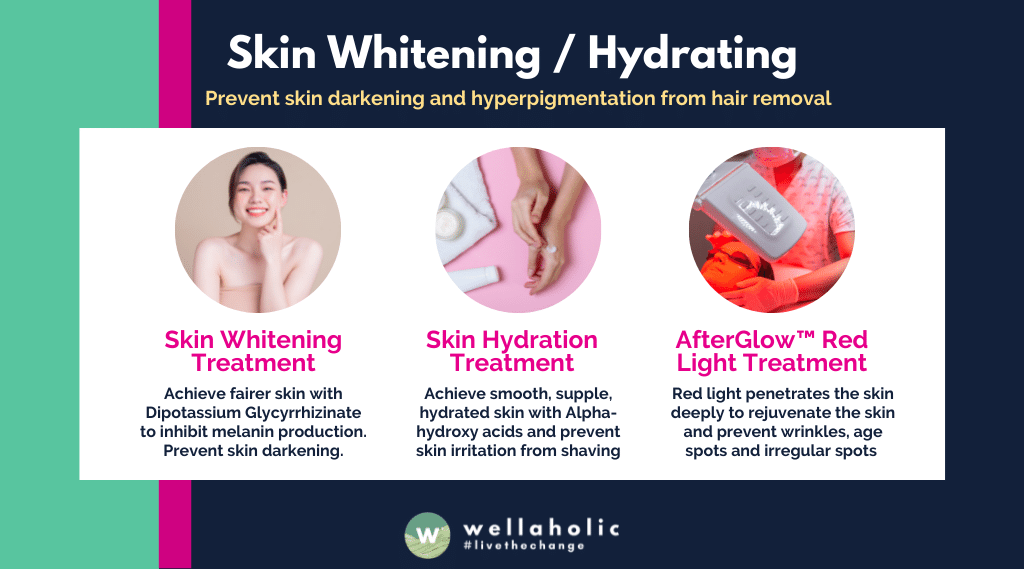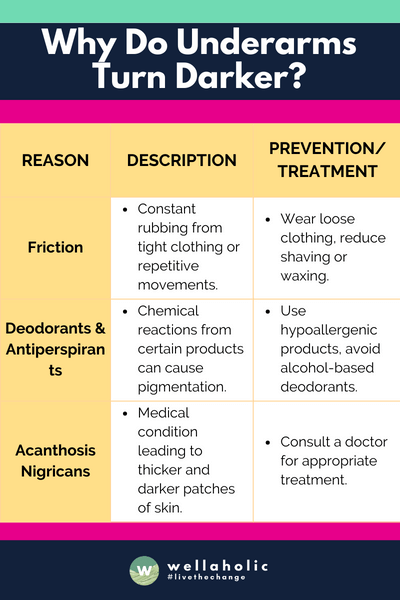
Bare It All with Confidence: How to Shave Your Underarms without Darkening Them

How to Prevent Dark Underarms When Shaving
Follow these expert tips to keep your underarms bright and smooth!
- 🧽 Exfoliate: Gently scrub to remove dead skin cells and prevent ingrown hairs.
- ✂️ Trim First: Use an electric trimmer on long hair to avoid tugging.
- 🪒 Sharp Razor: Always use a fresh, sharp razor and shave in the direction of hair growth.
- 🧴 Shaving Gel: Apply fragrance-free gel or oil for smooth gliding and skin protection.
- 💧 Cool Rinse: Rinse with cool water and pat dry after shaving.
Want smoother, brighter underarms?
Book Your Treatment NowIntroduction
As an Aesthetic Director with a deep understanding of skin health, I’ve observed that many individuals seek smooth, hair-free underarms. This preference isn’t just for aesthetic reasons; it also helps in reducing body odours.
Shaving, a common method for underarm hair removal, is accessible and cost-effective. Whether using a traditional razor or an electric shaver, it’s a popular choice. Frequent shaving can cause problems like darkening of the underarm skin and dryness. These are common concerns for my clients.
In the next part of this article, I’ll dive into how to choose the best products and methods for shaving. These tips will help keep your underarms looking smooth and even-toned.
“Shave your underarms with care, and you’ll be rewarded with smooth and radiant skin!
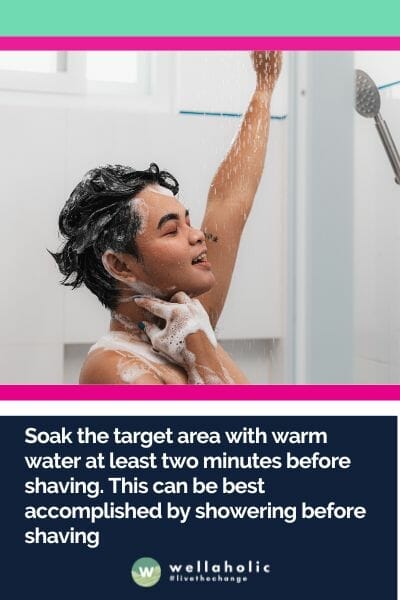
1. Soften Your Skin with Warm Water Before Shaving
As an experienced Aesthetic Director, I understand the importance of properly preparing the skin before shaving, especially for those with sensitive skin. shaving experience. I always advise to begin by softening the skin with warm water.
This method can give you a closer and smoother shave, reducing the chances of cuts, irritation, and darkened skin. It is especially vital in areas like the underarms where sensitivity is heightened. Remember, a comfortable shave isn’t the only reason to adopt this technique.
Moreover, using a wet towel to gently exfoliate the skin before shaving can be highly beneficial. It removes dead skin cells, preventing them from clogging the razor. This not only ensures a more efficient shave but also contributes to the overall health of your skin.
2. Exfoliate the Areas Before Shaving
Based on advice given to our customers, I’ve learned that the health of our skin extends beyond just our face. Our underarms, often overlooked, require similar care. This area of our body is prone to the accumulation of bacteria, sweat, and dirt, leading to blocked hair follicles. These blockages can cause unpleasant odours, irritation, and even infections. The key to maintaining underarm health is through regular exfoliation, a process that effectively removes dead skin cells and impurities.
Exfoliation can be achieved through two primary methods: physical and chemical. Physical exfoliation involves using a scrub with small particles that manually remove dead skin cells. This method is straightforward and can be easily incorporated into your daily shower routine. Chemical exfoliation, on the other hand, uses specific ingredients to dissolve dead skin cells. This can be a gentler option for those with sensitive skin.
Regular exfoliation of the underarms not only maintains cleanliness and health but also enhances the effectiveness of shaving. Smooth, exfoliated skin allows for a closer shave, reducing the frequency of shaving and resulting in longer-lasting smoothness.
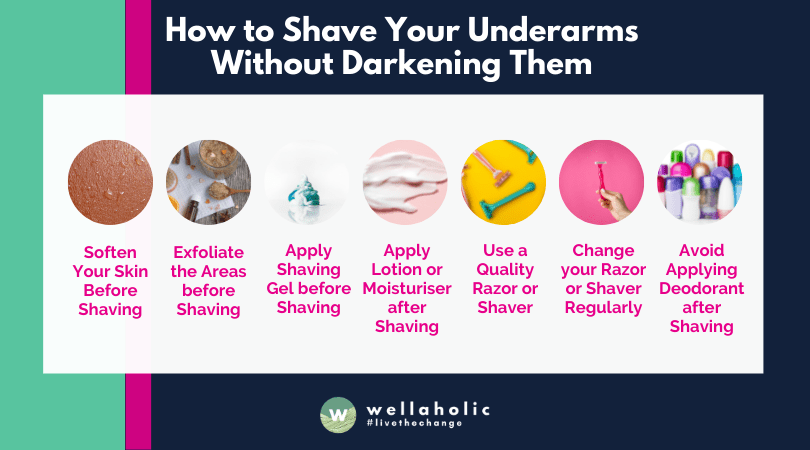
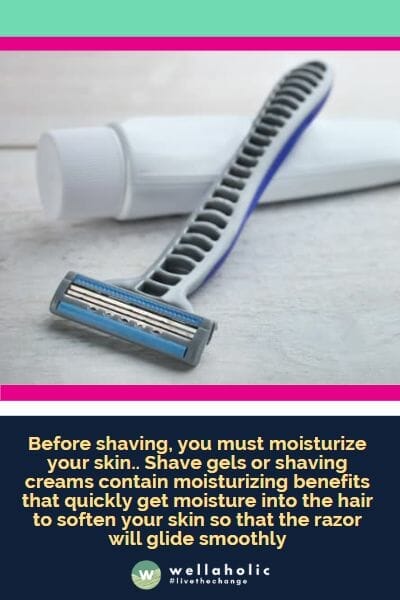
3. Apply Shaving Gel Before Shaving
What you do before shaving is also important. You should moisturize your skin before you shave. You can use shave gels or shaving creams that have moisturizing benefits. They help to make your hair softer and wetter so that the razor can slide smoothly. They also help you to get rid of body hairs that are hard to reach. Your underarms skin is very soft and sensitive, so it can get irritated easily.
According to Dr. David Lortscher, a dermatologist at the University of Cincinnati, “Applying shaving gel before shaving is one of the best ways to prevent razor burn and irritation. Shaving gel reduces friction and helps the razor glide smoothly over the skin by creating a barrier between the skin and the razor.
Importance of Proper Shaving Techniques
In my practice, I emphasize the importance of proper shaving techniques. The underarm skin is delicate and prone to irritation. Improper shaving can cause cuts, razor burn, bumps, and ingrown hairs, which can darken the skin. It’s vital to use a sharp, clean razor, shave in the direction of hair growth, and moisturize the skin afterward. These steps can help minimize irritation and promote healthier skin
- Use a sharp and clean razor. A dull or dirty razor can cause more friction and damage your skin.
- Shave in the direction of hair growth. This will reduce the risk of ingrown hair and razor bumps.
- Don’t press too hard on the razor. This will cause more irritation and inflammation.
- Rinse your razor after every stroke. This will remove any hair or cream that may clog the blades.
- Don’t shave too often. This will give your skin time to recover and avoid over-shaving.
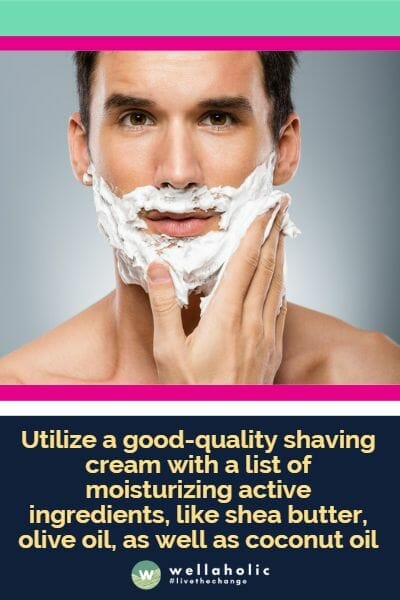
4. Apply Lotion or Moisturiser After Shaving
As an aesthetic director, I always emphasize the importance of proper skincare routines. One crucial step that often gets overlooked is applying lotion or moisturizer after shaving. Shaving can strip away your skin’s natural oils, leaving it feeling dry and irritated. That’s why I recommend massaging a nourishing lotion or moisturizer onto your freshly shaved skin.
This simple step helps replenish the lost moisture and soothes any razor burn or irritation. I’ve seen clients who neglected this step end up with dry, flaky patches or even ingrown hairs. A good moisturizer creates a protective barrier, allowing your skin to heal and preventing further issues. Personally, I love using a lightweight, fragrance-free lotion infused with soothing ingredients like aloe vera or chamomile extract. It leaves my skin feeling soft, supple, and refreshed after every shave.
5. Use a Quality Shaver or Razor
Always remember to use a sharp and clean razor. Remember to check your razor for signs of rust and avoid using the same razor day after day. A sharp razor will remove the hair quickly, and you won’t have to glide again and again. The rubbing action of the razor cuts your skin and when that skin heals, it darkens. It also causes razor bumps and scars.
So, it is better to use branded razors, which have high quality blades. It will be better to choose a multi-blade razor, 3 or more. Take a clean, sharp razor; never use dull blades! If you want a closer shave, then you can shave against the direction of hair growth, but it will cause ingrown hair and razor bumps.
According to Dr. Joshua Zeichner, a dermatologist at Mount Sinai Hospital in New York City, “the best way to choose between a shaver and a razor is to consider your skin type and shaving needs. If you have sensitive skin, a shaver may be a better option for you. If you are looking for a close shave, a razor may be a better choice.”
Dr. Zeichner also recommends investing in a quality shaving tool, regardless of whether you choose a shaver or a razor. “A good quality shaver or razor will last longer and provide a better shave than a cheaper model,” he says.
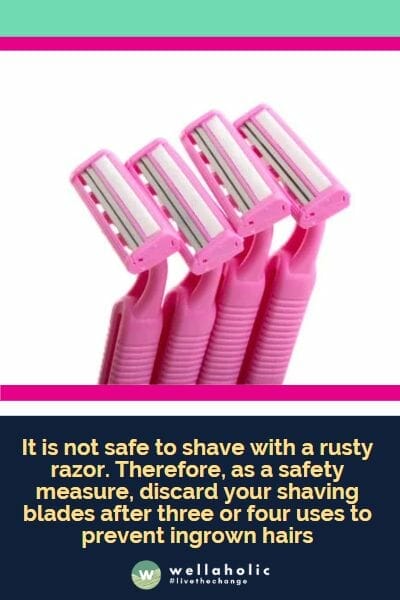
6. Change Your Shaver or Razor Regularly
It is not safe to shave with a rusty razor. Therefore, as a safety measure, discard your shaving blades after three or four uses to prevent ingrown hairs. You must replace razor blades after using it 3-4 times. Rinse your razor properly after using it. Store your razor properly by keeping it dry. Because moisture will cause rust. This will help to prevent dark underarms.
How to choose the right shaver or razor.
Exploring our clients’ shaving routines has been quite enlightening. Electric shavers stand out, especially for those who often shave or battle with sensitive skin. They’re a game-changer, minimizing irritation and making the daily shave a breeze. It’s clear that electric shavers have a leg up on traditional razors when it comes to keeping skin happy.
For folks who shave less frequently but chase that ultra-close shave, traditional razors are still king. Achieving that flawless finish takes a bit more effort and know-how, especially in using the right shaving aids and technique. And let’s not forget about keeping those blades sharp and clean to avoid any nicks or irritation.
When it comes to choosing a razor, it’s all about personal preference and skin needs. Safety razors, with their single blade, promise durability and less waste, though they come with a learning curve. Cartridge razors are easy to use and find, but they might be tougher on your wallet and skin over time. Disposable razors are all about convenience and saving pennies, but they’re not the best for your skin or the planet.
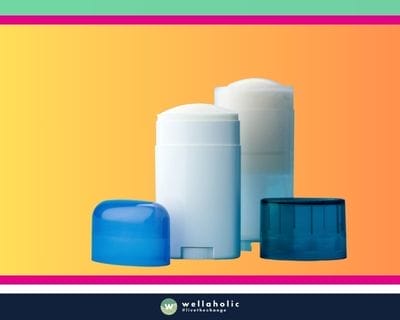
7. Avoid Applying Deodorant after Shaving
I can’t stress (further) the importance of treating our skin with care, especially after hair removal. It’s crucial to give your skin a breather after shaving before applying any antiperspirant. This practice helps in minimizing irritation, as freshly shaven skin can be particularly sensitive. The discomfort caused by deodorant use after shaving is often due to ingredients like alcohol and aluminium oxide, which are commonly found in many deodorants sold without a prescription.
Dr. Marisa Garshick, a dermatologist at Mount Sinai Hospital in New York City, is another expert who advises against applying deodorant immediately after shaving. She says, “Shaving can cause microscopic tears in the skin, which can make it more sensitive to the ingredients in deodorant. Applying deodorant too soon after shaving can irritate the skin and cause redness, burning, and itching.”
Here is a table with tips on how to shave your underarms without darkening them:
| Tip | Description |
|---|---|
| Exfoliate | Exfoliate the underarm area before shaving to break up bacteria, dirt, and sweat from clogged hair follicles. You can use a physical or chemical exfoliator, or both, to get the most effective shave. |
| Use a sharp razor | A dull razor can cause irritation and increase the risk of darkening the underarm area. Use a sharp razor with multiple blades to minimize the risk of cuts and ingrown hairs. |
| Shave in the shower | Shaving in the shower can help open up the hair follicles and make the hair easier to remove. It can also help reduce the risk of irritation and ingrown hairs. |
| Apply shaving cream | Applying shaving cream or gel can help lubricate the skin and reduce the risk of razor burn and irritation. Choose a cream that is formulated for sensitive skin and avoid those that contain alcohol. |
| Moisturize after shaving | After shaving, apply a moisturizer to the underarm area to soothe the skin and prevent dryness. Choose a moisturizer that is non-comedogenic and fragrance-free to reduce the risk of irritation. |

Insights from the Treatment Room: Wellaholic’s First-hand Observations
In our personal experience with customers at Wellaholic, we have observed a few interesting points regarding underarm hair removal and skin care:
Many clients come to us seeking solutions for darkened underarm skin caused by improper shaving techniques. Shaving without properly preparing the skin can lead to irritation, ingrown hairs, and discoloration. We emphasize the importance of exfoliating and using warm water to soften the hair before shaving. This simple step can make a significant difference in achieving a smooth, even-toned result.
Another common concern is dryness and irritation after shaving. We advise our clients to apply a gentle, fragrance-free moisturizer immediately after shaving to soothe the skin and prevent further irritation. Moisturizing also helps to keep the underarm area looking bright and healthy.
For those with sensitive skin or a preference for a closer shave, we often recommend using a high-quality razor or electric shaver. Investing in a quality shaving tool can minimize irritation and provide a more comfortable shaving experience. We also stress the importance of changing razors regularly to avoid dullness and potential skin issues.
Lastly, we caution against applying deodorant or antiperspirant immediately after shaving. The freshly shaved skin can be more susceptible to irritation from the ingredients in these products. We advise our clients to wait at least 30 minutes before applying deodorant to allow the skin to recover from the shaving process.
Frequently Asked Questions (FAQ)
What causes underarm darkening and how can I prevent it?
A: As the Aesthetic Director at Wellaholic with over a decade of experience, I can share that underarm darkening is commonly caused by friction, irritation, or hyperpigmentation. Shaving or waxing can irritate the area, leading to dark spots. Tight clothing creates friction while deodorants with harsh chemicals may cause irritation. Hormonal changes or medical conditions like diabetes can also trigger excess melanin production, resulting in darker underarms. To prevent this, I recommend exfoliating regularly, using gentle hair removal methods, wearing breathable fabrics, and choosing mild deodorant formulas. Maintaining proper hygiene and protecting the area from excessive sweating or sun exposure can also help keep your underarms bright.
: What are the best shaving products and techniques for preventing underarm darkening?
A: Using a moisturizing shaving cream or gel along with a sharp, clean razor can help. Shave in the direction of hair growth and avoid excessive pressure. This reduces the likelihood of irritation and darkening.
Are there natural remedies or treatments for underarm darkening?
A: As an experienced aesthetic director, I recommend several natural remedies for underarm darkening. Lemon juice contains citric acid that can help lighten skin. Potato slices or juice provide natural bleaching effects. A paste of turmeric and yogurt brightens while reducing inflammation. Coconut oil, rich in vitamins and fatty acids, helps moisturize and even out skin tone. Aloe vera gel soothes irritation and fades darkness. These gentle, plant-based remedies can be safely applied to underarms.
How can I lighten my underarms with laser hair removal?
A: Laser hair removal not only removes hair but can also lighten underarms by targeting pigmented areas. The treatment is safe and effective, providing long-lasting results with minimal discomfort.
Does shaving cause underarms to darken, and how can I avoid it?
A: Shaving can cause underarms to darken due to friction and improper technique. To avoid this, use a clean, sharp razor, moisturizing shaving products, and follow a proper post-shave care routine.
What are some myths and facts about underarm darkening?
A: As the Aesthetic Director at Wellaholic with over a decade of experience, let me clarify some myths and facts about underarm darkening. It’s a myth that waxing or plucking doesn’t cause chicken skin – the trauma leads to inflammation and bumps. Lotions alone can’t whiten dark underarms as there are different causes. Laser hair removal improves rather than causes chicken skin. Lemon or kalamansi may irritate the sensitive underarm area. Factors like pregnancy, genetics, and hormonal issues contribute to underarm darkening.The fact is shaving, scratching, and skin conditions like acanthosis nigricans can darken underarms. Proper hair removal techniques, mild products, and treating underlying causes help manage the issue.

Serene Chiam, Aesthetic Director (LinkedIn)
Serene Chiam is the Aesthetic Director at Wellaholic, a prominent aesthetic chain in Singapore. With over a decade of expertise in the aesthetics industry, Serene brings a wealth of knowledge and experience to her role. She holds a CIDESCO certificate in skincare and a Bachelor of Health Science (Aesthetics) from Torrens University, Australia. Prior to joining Wellaholic, Serene served as a Clinical Aesthetics Manager at Laser Clinics Australia, further honing her skills in laser treatments and skin rejuvenation. Her deep understanding of skin health and her commitment to providing personalized care have made her a sought-after professional in the field. Serene’s expertise and dedication ensure that Wellaholic’s clients receive the highest quality aesthetic treatments tailored to their individual needs.
Contact Serene at [email protected]
GET IN TOUCH
Book Now Pay Later
Skin Whitening / Hydrating (PTT) by Wellaholic
- ⭐ Prevent Skin Darkening from Hair Removal. Skin Whitening / Hydrating (PTT) prevents skin darkening (hyperpigmentation) and dryness after laser hair removal.
- ⭐ Whitening or Hydrating. Choose between whitening (half body) or hydrating (half body) based on your skin concerns.
- ⭐ AfterGlow™ Red Light. Finish with AfterGlow™ red light therapy to repair and rejuvenate your skin.
- ⭐ Award-Winning. Wellaholic’s treatments have been recognized by top beauty publications such as Daily Vanity, Beauty Insider, and Tropika Club Magazine.
- ⭐ Over 2000 Verified Customer Reviews. Wellaholic has over 30 industry awards and over 2000 positive reviews from customers, and >50% are repeat customers.
